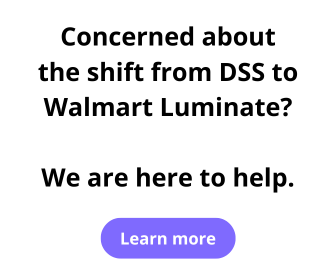Thoughts From A Walmart Replenishment Veteran
As a 17-year veteran in the Walmart supplier community, much of that in various replenishment roles, I found that the events of 2020 offered a case study for planning and communication.
Though there was no way to anticipate the events that transpired in 2020, proper planning and communication helped mitigate this challenge’s impacts to production and supply chain operations.
Replenishment and forecasting require data to establish baselines. Metrics and operational considerations include sales history, removal of atypical events, future modular plans, and communication with the key players in the supply chain. When any one of these considerations is overlooked or inaccurate, the entire supply chain becomes ineffective. The result is significant deficiencies to store instock levels.
While the supplier world simply could not have foreseen what would happen in 2020, the events served to highlight the importance of having a robust and thorough supply plan.
Alignment with an existing forecast
Imagine a perfect world with no anomalous events and perfect forecast accuracy. Even an ideal scenario like this is for naught if the supplier does not align the existing forecast and supply plan. Suppliers who aligned with Walmart’s expectations still saw significant challenges to their supply chain operations. Still, suppliers who were already behind the curve saw much more significant impacts on their store instock levels.
Proper forecast alignment and effective communication with Walmart are critical and should be second nature to suppliers. These best practices serve to mitigate the impact of unanticipated events like the 2020 pandemic.
Communication
Often, the worst conversations with Walmart center around supply chain interruptions. It is never fun to share your challenges with your “boss.” However, communicating both the good and bad insights with your replenishment associates allows them to react and make any possible changes to lessen the impact of instock deficiencies.
With my suppliers, I had many conversations in 2020 involving this very topic. Some of my suppliers considered withholding critical information regarding their supply chain operations, while others opted to be completely transparent. My advice to everyone was to share everything: the good, the bad, and the very ugly.
Walmart’s supply chain is incredibly robust. The retailer has a fantastic ability to react to unforeseen circumstances. However, this ability to respond requires a thorough understanding of the reality of any challenges. Transparent communication from Walmart’s supplier partners can allow it to shift resources where needed, keeping the flow of goods as consistent as possible.
Safety stock
No company likes excess inventory. Suppliers have concerns about producing a product in anticipation of a Walmart order, while no such guarantee of the order exists until Walmart transmits the purchase order. Additionally, storage costs eat into suppliers’ already razor-thin margins.
The amount of safety stock that a supplier should maintain is not a fixed number. All categories are different, so the number of weeks of safety stock that one supplier should maintain could differ from another supplier. Regardless of that number, all suppliers should carefully consider the pros and cons of safety stock.
Many suppliers fulfill Walmart orders as direct imports. Walmart takes possession of the inventory at the foreign port and handles all transportation and logistics from that point. However, given the lead times of sometimes 60 days or more, this scenario can lead to significant instocks and slow reaction times when unforeseen events occur.
One suggestion that I have helped implement with my suppliers is to approach Walmart with a hybrid solution. The recommendations centered around a blended solution of both direct import and domestic fulfillment. In this scenario, the supplier would fulfill the majority of the orders via the direct import channel.
In Conclusion
Let’s face it. The year 2020 was a nightmare for both retailers and suppliers. Supply chain operations that are a challenge in the best of times became strained to the breaking point last year.
While nobody could have predicted these events, suppliers who had already aligned with Walmart’s expectations, forecasts, and supply plans were in a much better position to react to the surge in demand. Alignment with expectations and communication have always been the hallmark of a successful supply chain, and 2020 only highlighted the importance of these best practices.
Additionally, the supplier would bring a smaller percentage of the inventory into the country to fulfill domestically. Given the fast lead times with domestic fulfillment, this approach helped my suppliers react much more quickly to the sudden shifts in demand. It allowed them to maintain sufficient instock levels throughout the pandemic.
Receive notifications of new Walmart inititives, supplier resources and educational articles — delivered to your inbox!
Additional Articles
The evolution of consumer shopping patterns, including the rise of online shopping and the demand for personalized experiences has given Walmart access to a wealth of omnichannel data.
The new compliance program for suppliers can result in fees per item, per location, and per unit affected.
